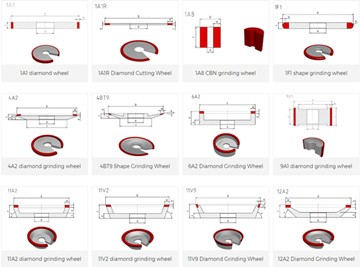Choose the right Grinding Wheel – Sizes & Types

Sizes & Types of Grinding Wheels
The diameter of a grinding wheel can range from just 1″ to 20″, they can go from just 0.035″ to up to 1/2″ thick. The smallest wheels are used for different operations like auto body work while the largest ones can cut through railway tracks and thick metal constructions.
There are also different types of grinding wheels, such as:
Straight wheels, which are the most common style of wheels used for cylindrical, centerless and surface grinding operations, and are found on bench or pedestal grinders; they’re used for creating slightly concave surface;
Cylinder or wheel rings, which are used in vertical or horizontal spindle grinders and have no center mounting support; they’re used for creating flat surfaces by using the end face of the wheel;
Tapered wheels, which typically used for operations, like grinding thread and gear teeth; it’s basically a straight wheel that tapers towards wheel center, but it can accept higher lateral loads;
Straight cup wheels, which are used for producing additional radial grinding surface;
Dish cup wheels, which are used primarily in cutter grinding and jig grinding;
Saucer wheels, typically used for grinding milling cutters and twist drills;
Diamond wheels, used for grinding extremely hard materials (like carbide cutting tips, concrete, gemstones, etc.);
Small mounted wheels, which are mounted on a steel mandrel, typically of hand tool; they come at all kinds of variations (different grains, bonds, etc.) and are therefore used for various operations, typically different off-hand and precision grinding jobs;
Cut-off wheels, which are normally used on angle grinders for quick removal or trimming; they’re thin and usually have radial fibers as reinforcement.
Conclusion: The Perfect Wheel Is…?
We showed you different grinding wheel properties, all you need to do now is to put the correct ones together and get a perfect grinding wheel for your needs!
In case you are working on a hard material, you’ll probably want to use a softer grade and a fine-grit wheel, as hard materials resist the drilling of the abrasive grains into the surface, which dulls them quite quickly. The combination of a finer grit and a softer grade would be perfect, as the grains will dull, break away and leave new, sharp cutting points. In case you are working on softer materials, wheels with a coarse grit and harder grade would be the correct way to go.
Stock-removal speed is another factor to consider, so in case you need a wheel with rapid stock removal, you should choose coarser grits. The penetration level is greater, and they leave heavier cuts. Wheels with finer grits cut faster, so they are a perfect option for material that is hard to penetrate.
The abrasive material used in the making of the wheels, as well as the bond material, are one of the first things to consider. Different abrasive types are intended to be used on different materials – like we mentioned earlier in the article, aluminum oxide or zirconia-alumina should be used on steels and steel alloys, while silicon carbide is a suitable option for non-metallics, non-ferrous metals and cast iron. As for the different types of bonds, vitrified bonds have fast cutting abilities, rubber, resin or shellac bonds are used in case you wish to remove a smaller amount of stock or in case you want to achieve finer finishes.
Wheel speed is also an important factor to consider as different wheels can be used at different speeds. For example, vitrified wheels are used at speeds up to 6,500 SFPM, while organic-bond wheels can be used on speeds between 6,500 and 9,500 SFPM.
You should also think about the contact area between the grinding wheel and workpiece. In case you are dealing with a large area of contact, you should probably use a softer grade and coarser grit wheel. Finer grit and harder grade wheels are more suitable for a smaller area of grinding contact.
There are also wheels that are designed to bear a lot of pressure that created when the wheel and the workpiece are pressed together, plus, grinding machine horsepower should not be overlooked neither. A useful guideline would be: if the horsepower is smaller than the diameter of the grinding wheel, then a softer-grade wheel should be used, and harder-grade wheel should be used in opposite situations.
